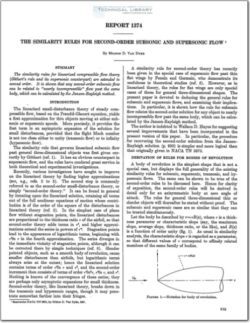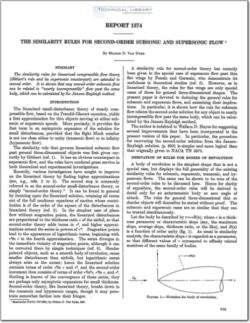NACA-Report-1374

- Version
- 218 Downloads
- 898.64 KB File Size
- 1 File Count
- December 4, 2015 Create Date
- December 4, 2015 Last Updated
National Advisory Committee for Aeronautics, Report - The Similarity Rules for Second Order Subsonic and Supersonic Flow

The similarity rules for linearized compressible flow theory
(Gothert’s rule and its supersonic counterpart) are attended to
second order. It is shown that any second-order subsonic flow
can be related to “nearly incompressible” flow past the same
body, which can be calculated by the Janeen-Rayleigh method.
The linearized small—disturbance theory of steady com-
pressible flow, based on the Prandtl—Glauert equation, yields
a first approm'mation for thin objects moving at either sub-
sonic or supersonic speeds. More precisely, it provides the
first term in an asymptotic expansion of the solution for
small disturbances, provided that the flight Mach number
is not too close either to unity (transomie flow) or to infinity
(hypersonic flow).
The similarity rule that governs linearized subsonic flow
past general three-dimensional objects was first given cor-
rectly by Gathert (ref. 1).
supersonic flow, and the rules have rendered great service in
both theoretical and experimental investigations.
Recently, various investigators have sought to improve
on the linearized theory by finding higher approximations
(see, e.g., refs. 2 to 5). The second step is commonly
referred to as the second-order small-disturbance theory, or
simply “second-order theory.” It can be found in general
by iterating upon the linearized solution, retaining all terms
out of the full nonlinear equations of motion whose contri-
bution is of the order of the square of the disturbances in
linearized theory (ref. 3). In the simplest case of plane
flow without stagnation points, the linearized disturbances
are proportional to the thickness ratio 1- of the airfoil, so that
second-order theory adds terms in 1-2, and higher approxi—
mations extend the series in powers of r“. Stagnation points
lead to the appearance of logarithmic terms, beginning with
flat -r in the fourth approximation. The series diverges in
the immediate vicinity of stagnation points, although it can
be corrected there by simple techniques (ref. 6). Slender
pointed objects, such as a smooth body of revolution, cause
smaller disturbances than airfoils, but logarithmic terms
always arise at the outset; hence the linearized solution
contains terms of order #ln 1" and 72, and the second-order
increment then consists of terms of order fln‘r, r‘ln r, and 7‘.
Nothing is known of the convergence of these series; they
are perhaps only asymptotic expansions for small thickness.
Second—order theory, like linearized theory, breaks down in
the transonic and hypersonic ranges, though it may pene-
trate somewhat farther into their fringes.
| File | Action |
|---|---|
| naca-report-1374.pdf | Download |

Comment On This Post